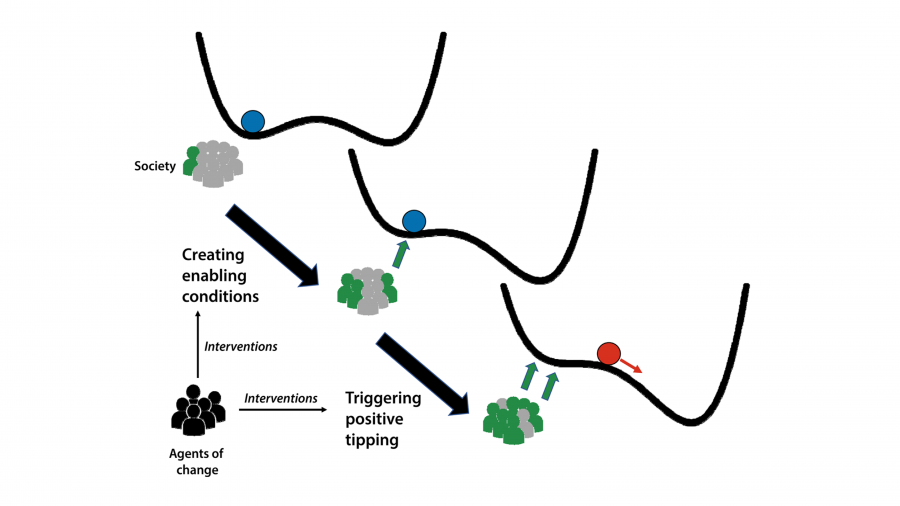
Due to the many interactions and feedbacks in a complex system, changes in one part of the system can have cascading effects causing sequential changes in other parts. Cascading effects can occur in many types of complex systems, including ecological, social, and socio-environmental ones. As the associated Explainer “Introduction to Cascades: Ecological, Social, and Socio-Environmental” describes, cascades of change can often lead to tipping points. To address the intensifying need to achieve social change that creates more sustainable systems, researchers study the dynamics of behavioral cascades. While the phrase “tipping points” is applied broadly to ecological and socio-ecological systems, behavioral cascades are sometimes simply called tipping points. The analysis of tipping points, illustrated in a study by Lenton et al. (2022), identifies sectors in which intentional cascades of change in social behavior are most likely to find momentum through specific enabling conditions and positive (reinforcing) feedbacks. Social cascades can involve the spread of social norms from a critical mass of early adopters to a mainstream practice, as exhibited in the surge in renewable energy, microtransportation, and LED lighting. (For more examples, see Winkelmann et al. 2022.) Small changes in a social system can “nudge” it into a different state because of reinforcing feedbacks (e.g., Michels et al. 2023). Enabling conditions for creating positive behavioral cascades include strategies that target small populations; alter social network structure; provide relevant information; reduce price; improve quality or performance; increase desirability; increase accessibility; and coordinate complementary technologies (Lenton et al.). Innovations from social, technological, and ecological sectors, as well as policy innovation, private and public investment, better communication with the public, and behavioral nudges, help reinforce the momentum of positive cascades (e.g., Geels and Ayoub 2023).
This second lesson, in a three-part series on cascading effects, focuses on social cascades. Here, learners investigate sectors ripe for cascades and develop plans to enable cascades that will lead to positive social changes. The first lesson introduces cascading effects using ecological cascades—especially trophic cascades—as an example. The third lesson focuses on socio-environmental cascades using climate change impacts that cascade socio-economically and ecologically. Learners investigate types of changes in governance that may better protect built infrastructure, humans, and economic systems.
- Study how cascades flow sequentially through socio-environmental networks and how this phenomenon can shape policy and conservation strategies.
- Identify sectors and specific venues in which enabling conditions, policy, and investment may catalyze behavioral cascades.
- Outline a cascade implementation strategy for a specific area of environmental action.

The Critical Mass
The “critical mass” is an interdisciplinary concept with applications in physics, psychology, sociology, and business, among others. For this socio-environmental lesson, the critical mass describes a forerunning minority of people who are trendsetters, early adopters, and change-makers who lead others to adopt a pro-environmental behavior. For 2 minutes, have learners brainstorm specific examples of where they witnessed or participated in a critical mass that successfully changed a social norm or behavior. For example, a few students in a high school might start a school food waste composting program by collecting cafeteria food scraps, starting a compost bin, and normalizing that behavior with their peers. For 3 minutes, ask learners to share their examples of changes to the group norm driven by a critical mass and the environmental results of these behavioral cascades.
Cascades of Social Behavior in S-E Systems (One, 75-minute class with an optional extension)
-
As preparation for the session, have learners read the study by Lenton et al. (2022), paying special attention to the highlighted areas.
DocumentLenton et al. 2022 – Highlighted.pdf (614.79 KB) -
(10 min.) Open the session by reviewing the basics of cascades and social change using the lesson’s PPT slides below.
Document -
(5 min.) Divide the class into groups of three to five learners and review the following areas of environmental action. You may have multiple groups for each area, and you may have groups choose their topic.
- Adopt microtransportation (e-bikes, scooters, etc.) to reduce automobile loads in urban areas
- Replace meat with alternative vegetarian “meat” products to reduce climate impacts
- Increase renewable energy adoption to make the electric grid more sustainable
- Replace lawns with urban and suburban gardens, edible forests, and wildflower meadows
- Increase the share of residents who use personal compost bins or participate in municipal compost programs to reduce landfilled biomass
- Foster programs to distribute used clothing and repurpose old textiles to reduce landfill waste
- Enhance the efficacy of social media-based environmental campaigns.
-
(15 min.) As a full class, briefly run through these areas of action and ask learners to share their knowledge of the difficulties of achieving social change in each sector. For example, learners may be aware that the alt-meat industry has recently faced difficulties in growing their market share of meat consumption and has even seen reduced sales after an initial period of consumer enthusiasm. Take one case study, like alt-meat, and have the full class brainstorm the levels of social resistance that innovators must navigate to achieve a cascade effect. For alt-meat, these challenges have emerged:
- The design rationale to make these products perfectly mimic meat has faltered on gustatory and aesthetic levels.
- Alt-meats are highly processed, even engineered, foods: unappealing to consumers who prefer unprocessed and whole foods.
- Alt-meats are sold at two to four times the price of genuine meats.
Learners should offer initial ideas about ways to redress these challenges using an analytical frame that integrates enabling conditions. Consider strategies that:- Target small populations
- Alter social network structure
- Provide relevant information
- Reduce price
- Improve quality or performance
- Increase desirability
- Increase accessibility
- Coordinate complementary technologies.
-
(25 min.) Now the small groups have time to research their topic in greater depth to uncover challenges to social acceptance and design-enabling conditions that create cascades. Have the groups collaborate on a shared document in which they compile research on adoption challenges and describe the resistant social conditions that may be re-designed as enabling conditions. Have each group identify three challenges and three enabling conditions that may resolve the challenge. Groups should create a single visual slide that summarizes their findings.
-
(15 min.) With the remaining class time, give each group ~3 minutes to share their slide on challenges and enabling conditions for a given cascade. Post these slides in the online course space.
-
As homework, have each learner provide feedback to another group on their ideas, including further information, research, and suggestions for tailoring enabling conditions to specific small populations.
-
As an optional extension, use this lesson as a starting point for a semester-length project in which learners in small groups research, design, and implement enabling conditions that target small populations and aim to create cascades in which this sustainable behavior is more widely adopted. They may find that college campuses create their own enabling conditions because of the youth, advocacy, knowledge, and willingness to try new behaviors that are typical of collegiate environments.
-
Cascading climate change impacts and implications
This research paper focuses on the social implications of climate change cascades in New Zealand. The authors describe interdependencies between natural and socio-economic systems in response to changes and feedback loops. They analyze how the combined effects of interacting stressors may affect the ability of individuals, governments, and the private sector to adapt in time and build resilience to further damage. They use critical systems thinking to characterize how climate change impacts cascade across domains, show the implications for cascade governance, and explore resource priorities in climate change adaptation.
Lawrence, J., Blackett, P., & Cradock-Henry, N.A. (2020). Cascading climate change impacts and implications. Climate Risk Management, 29, 100234. https://doi.org/10.1016/j.crm.2020.100234.
-
Cascades Game
This interactive simulation game supported by the EU’s Horizon 2020 program provides an immersive scenario in which participants choose among the roles of policy maker, science advisor, business representative, and activist. The “cascade” here refers to amplifying climate feedbacks and a condensed window in which international stakeholders must coordinate and take action to protect the global food system. The game takes about two hours to play and supports a range of group size from 5–60 players.
Cascades Game. (n.d.). Homepage. https://cascades.socialsimulations.org/
-
Social tipping dynamics for stabilizing Earth’s climate by 2050
This research article uses a literature review and interviews of experts to articulate concrete interventions that induce social tipping points toward reducing greenhouse gas emissions and achieving carbon neutrality by 2050. The authors discuss problematic fossil fuel subsidies, divesting fossil fuel assets, changing the moral norms surrounding fossil fuel use, and strengthening education and advocacy among younger populations.
Otto, I.M., Donges, J.F., Cremades, R. et al. (2020). Social tipping dynamics for stabilizing Earth’s climate by 2050. PNAS, 117(5) 2354-2365. https://doi.org/10.1073/pnas.1900577117